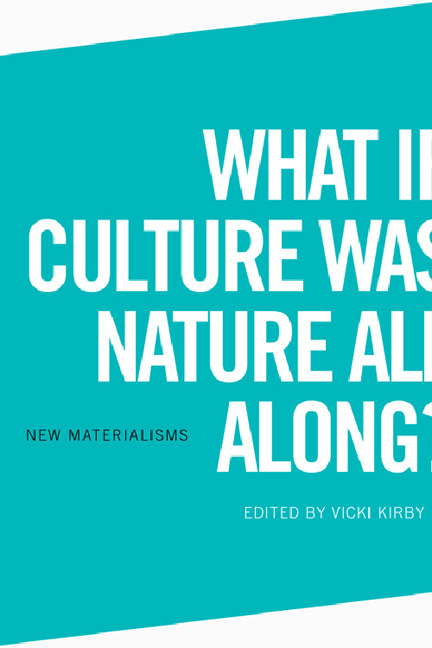Book contents
- Frontmatter
- Contents
- Acknowledgements
- Foreword
- 1 Matter out of Place: ‘New Materialism’ in Review
- 2 Method Matters: The Ethics of Exclusion
- 3 Sensory Substitution: The Plasticity of the Eye/I
- 4 Allergy as the Puzzle of Causality
- 5 Pregnant Men: Paternal Postnatal Depression and a Culture of Hormones
- 6 Material Culture: Epigenetics and the Molecularisation of the Social
- 7 Racialised Visual Encounters
- 8 Microbiology as Sociology: The Strange Sociality of Slime
- 9 Nature Represents Itself: Bibliophilia in a Changing Climate
- 10 Climate Change, Socially Synchronised: Are We Really Running out of Time?
- 11 A Sociality of Death: Towards a New Materialist Politics and Ethics of Life Itself
- Notes on Contributors
- Index
3 - Sensory Substitution: The Plasticity of the Eye/I
Published online by Cambridge University Press: 22 December 2017
- Frontmatter
- Contents
- Acknowledgements
- Foreword
- 1 Matter out of Place: ‘New Materialism’ in Review
- 2 Method Matters: The Ethics of Exclusion
- 3 Sensory Substitution: The Plasticity of the Eye/I
- 4 Allergy as the Puzzle of Causality
- 5 Pregnant Men: Paternal Postnatal Depression and a Culture of Hormones
- 6 Material Culture: Epigenetics and the Molecularisation of the Social
- 7 Racialised Visual Encounters
- 8 Microbiology as Sociology: The Strange Sociality of Slime
- 9 Nature Represents Itself: Bibliophilia in a Changing Climate
- 10 Climate Change, Socially Synchronised: Are We Really Running out of Time?
- 11 A Sociality of Death: Towards a New Materialist Politics and Ethics of Life Itself
- Notes on Contributors
- Index
Summary
When we think of perception most of us will call to mind everyday experiences of sight, smell, sound, touch and taste. Intuitively, we may also match the sensory perceptions we experience with their modal counterparts: we see with our eyes, hear with our ears, taste with our tongue, smell with our nose, touch with our skin. This classic definition of perception as an aggregate of different sensory modalities is also used in scientific approaches to the topic. In psychology textbooks, for instance, it is not uncommon to find stand-alone chapters devoted to explaining the functions and structures of each of the different senses (Chaudhuri 2011; Mathur 2009).
Implicit in this orthodox account is a causal and linear narrative: a discrete physical stimulus triggers a particular subjective response. Psychologist, George Mathur, explains the process like so: ‘we may sense “sound” when air pressure waves enter the ear; and we may sense “light” when electromagnetic radiation enters the eye’ (2009: 17, emphasis added). In a similar vein, perceptual psychologist, Avi Chaudhuri, describes how physical stimuli, as ‘raw data’, are transmitted via nerve impulses and sensory pathways to corresponding regions in the brain, where ‘sensory inputs are biologically processed to ultimately produce the experience of perception’ (2011: 36). While intuitive, these accounts of perception rest on a key assumption, namely, that the perceiver and the object of perception are discrete entities, separated by a biological or psychological interface through which sensory information passes. In other words, the process of perception relies on the object's externality from the perceiving subject or body.
In a similar vein, localisation is a foundational principle of modern neuroscience. Localisation theories posit that discrete regions in the brain are specialised for different functions (Kandel et al. 2013). Traditionally, neuroscientific explanations of sensory processing have been based on the ‘labelled line’ hypothesis in which ‘a single neuron codes for a single pre-determined dimension’ (Fotheringham and Young 1997: 48). According to psychologist Charles Gross, this hypothesis has also been termed the ‘grandmother cell’, indicating ‘a neuron that would respond only to a specific, complex, and meaningful stimulus, that is, to a single percept or even a single concept’ (2002: 512).
- Type
- Chapter
- Information
- What if Culture was Nature all Along? , pp. 48 - 69Publisher: Edinburgh University PressPrint publication year: 2017



